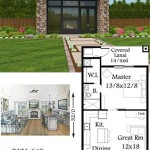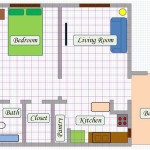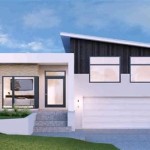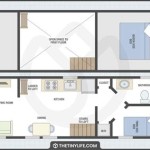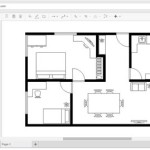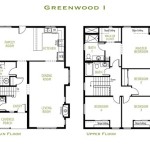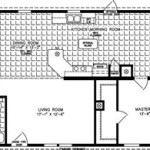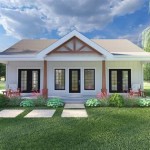House Plans: Maximizing Comfort and Efficiency in 1200 Sq Ft and Under
The demand for smaller, more efficient homes is steadily increasing. This trend is driven by factors such as affordability, sustainability concerns, and a growing desire for simplified living. House plans designed for homes 1200 sq ft and under offer a practical solution for individuals, couples, and small families seeking comfortable and functional living spaces without the burden of excessive square footage. These plans require careful consideration of space utilization, design principles, and lifestyle needs to create a dwelling that feels spacious and welcoming, despite its compact footprint.
Designing within these constraints presents both challenges and opportunities. It requires a strategic approach to layout, storage, and multi-functional areas. The goal is to eliminate unnecessary space and incorporate elements that enhance the perceived size and usability of the home. Successful small home designs prioritize natural light, open floor plans, and efficient circulation to create a comfortable and enjoyable living environment.
This article explores key considerations and design principles for creating effective house plans for homes 1200 sq ft and under. It examines the benefits of smaller homes, common design challenges, and strategies for maximizing space and functionality. The focus will be on providing clear, informative guidance for those considering building or renovating a smaller home.
Key Considerations for Small Home Design
Several factors play a crucial role in developing successful house plans for homes under 1200 sq ft. These considerations extend beyond simply shrinking larger house plans and involve a fundamental rethinking of how space is used and perceived. Addressing these factors upfront can significantly impact the livability and overall satisfaction with the finished home.
Lifestyle and Needs Assessment: Before embarking on any design process, a thorough assessment of the homeowner's lifestyle and needs is essential. This includes identifying the number of occupants, their daily routines, hobbies, and storage requirements. Understanding these aspects will inform decisions about the number of bedrooms and bathrooms, the size of the kitchen and living areas, and the need for dedicated workspaces or storage solutions. For instance, a single individual who frequently entertains may prioritize a larger living area and a well-equipped kitchen over a second bedroom.
Site Considerations: The characteristics of the building site can significantly influence the design of a small home. Factors such as the orientation of the lot, the slope of the land, and the surrounding environment should be carefully considered. Optimizing the orientation of the home to maximize natural light and passive solar gain can reduce energy consumption and create a more comfortable indoor environment. Sloping sites may require innovative foundation designs or multi-level layouts to effectively utilize the available space. The presence of trees, existing buildings, or neighboring properties may also impact the placement and design of the home.
Budget and Cost-Effectiveness: Building a smaller home generally translates to lower construction costs. However, it is crucial to establish a realistic budget and prioritize cost-effective design and construction techniques. Selecting durable, low-maintenance materials can reduce long-term maintenance expenses. Simple, efficient layouts tend to be more economical to build than complex, custom designs. Exploring prefabricated or modular construction options can also potentially reduce construction time and costs.
Design Principles for Maximizing Space and Functionality
Effective small home design relies on several key principles that prioritize space optimization and multi-functionality. These principles guide the layout and selection of interior elements to create a living environment that feels larger and more comfortable than its actual square footage. Careful attention to these principles can transform a potentially cramped space into a welcoming and efficient home.
Open Floor Plans: Open floor plans are a hallmark of successful small home designs. By eliminating walls between the kitchen, living, and dining areas, a sense of spaciousness is created. This allows for better circulation and natural light penetration throughout the home. Thoughtful zoning and furniture placement can define distinct living areas within the open space without the need for physical barriers. Consider using variations in flooring, rugs, or ceiling heights to subtly delineate different zones.
Vertical Space Utilization: Capitalizing on vertical space is essential in small homes. This involves incorporating tall ceilings, loft spaces, and vertical storage solutions. Tall ceilings can create a sense of airiness and make a room feel larger. Loft spaces can be used for sleeping areas, home offices, or storage. Utilizing vertical storage solutions, such as built-in shelving and cabinets that extend to the ceiling, can maximize storage capacity without occupying valuable floor space. Consider using wall-mounted beds or desks that can be folded away when not in use.
Multi-Functional Spaces: Designing spaces that serve multiple purposes is crucial in maximizing the functionality of a small home. A guest bedroom can double as a home office or library. A dining table can also serve as a workspace or craft area. Incorporating flexible furniture and storage solutions can facilitate these transformations. For example, a sofa bed can quickly convert a living room into a guest bedroom. A kitchen island can provide both counter space and seating for dining or casual meals. The key is to think creatively about how each space can serve multiple needs.
Specific Design Elements for Small Homes
Beyond the general design principles, specific design elements can contribute significantly to the success of a small home plan. These elements focus on enhancing natural light, improving storage, and creating a sense of visual openness. Incorporating these elements thoughtfully can elevate the functionality and aesthetics of a small home.
Natural Light Optimization: Maximizing natural light is crucial in small homes. Large windows, skylights, and light wells can flood the interior with daylight, making the space feel brighter and more spacious. Consider the orientation of the windows to capture sunlight throughout the day. Avoid heavy window treatments that block natural light. Light-colored walls and ceilings can reflect light and further enhance the brightness of the room. Strategic placement of mirrors can also amplify natural light and create the illusion of more space.
Clever Storage Solutions: Ample and well-designed storage is essential in maintaining a clutter-free and organized small home. Built-in storage, such as shelving, drawers, and cabinets, can maximize storage capacity without taking up valuable floor space. Under-bed storage, hidden compartments, and multi-functional furniture with integrated storage can further optimize space utilization. Consider utilizing vertical storage solutions, such as wall-mounted shelves and hooks, to keep items off the floor and create a more open feel. Regular decluttering is also crucial in maintaining a sense of spaciousness in a small home.
Visual Connection to the Outdoors: Creating a strong visual connection to the outdoors can make a small home feel larger and more inviting. Large windows, sliding glass doors, and outdoor living spaces can blur the boundaries between indoors and outdoors. Consider incorporating a deck, patio, or garden to extend the living space outward. Planting greenery around the home can enhance the connection to nature and create a more peaceful and relaxing environment. Maintaining a clear view of the outdoors can also reduce feelings of confinement and make the home feel more spacious.
Designing house plans for homes 1200 sq ft and under requires a careful and strategic approach. By prioritizing lifestyle needs, maximizing space utilization, and incorporating clever design elements, it is possible to create a comfortable, functional, and aesthetically pleasing living environment within a small footprint. The key is to embrace the challenges of small home design and focus on creating a space that truly reflects the needs and preferences of the occupants. This can result in a home that is not only affordable and sustainable but also a joy to live in.

Home Plans Homepw74380 1 200 Square Feet 2 Bedroom Bathroom With Garage Bays New House Craftsman Style Small Floor

17 Elegant 1200 Sq Ft House Plans 2 Bedroom Pics Open Concept Layout 1200sq

Cabin Style House Plan 2 Beds 1 Baths 1200 Sq Ft 117 790 Houseplans Com

Ranch Style House Plan 3 Beds 2 Baths 1200 Sq Ft 116 242 Houseplans Com
Ranch Home With 2 Bdrms 1200 Sq Ft House Plan 103 1099 Tpc

House Plan 45269 Ranch Style With 1200 Sq Ft 3 Bed 2 Bath

2 Bedroom House Plans 1000 Square Feet Home Homepw26841 1 200 3 Bathroom Small

2 Bedroom Cottage House Plan 1200 Sq Ft Cabin Style

12 1 200 Sq Ft House Plans We Love Blog Eplans Com

Small House Plans 1200 Square Feet

